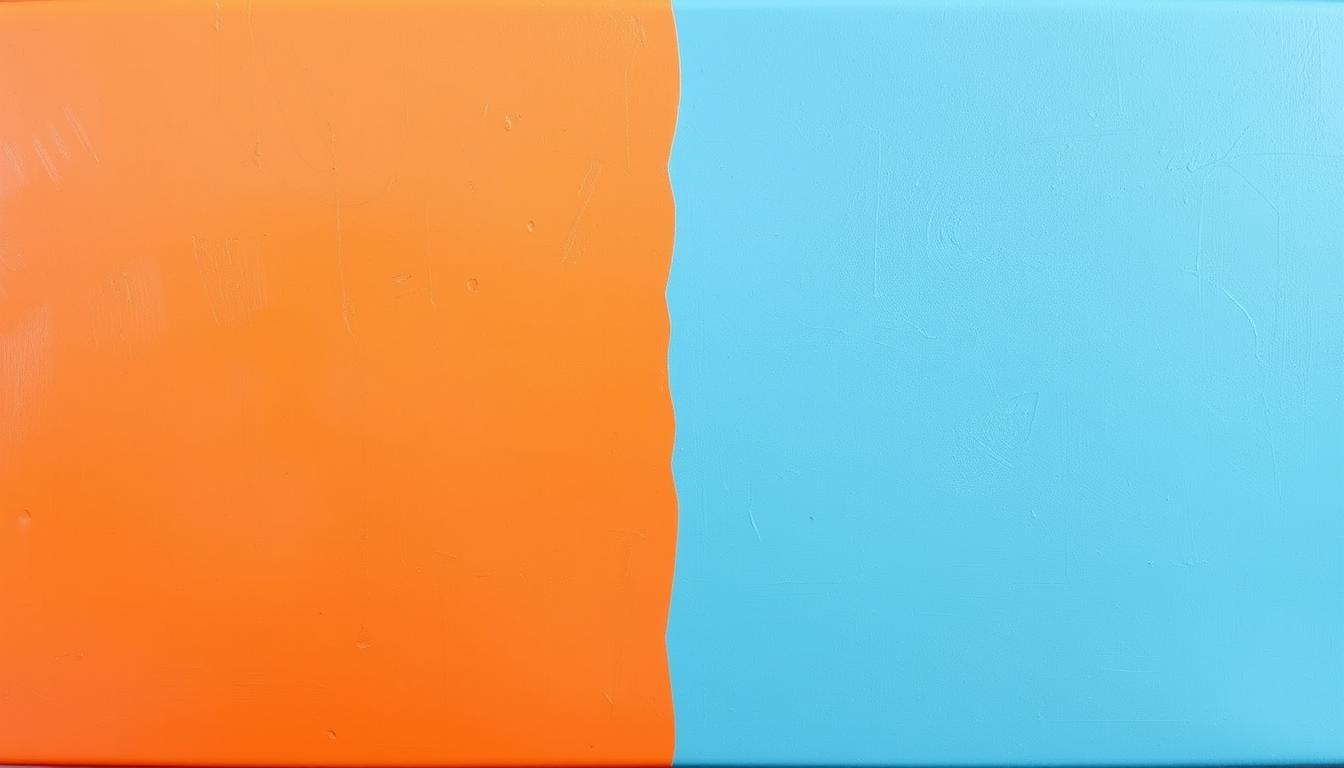Painting requires the right coverage for a professional finish. Coverage is how much surface a paint amount can cover. It’s vital to grasp the factors influencing it, like paint thickness. The right coverage enhances both the look and durability of the paint.
Paint thickness is key to a paint job’s quality. A thicker coat offers better coverage but risks drips and unevenness. A thinner coat might need more applications, raising costs and time. Knowing about coverage and thickness helps in making better painting choices.
Whether tackling a DIY task or a big commercial project, correct paint coverage is essential. This article delves into one-coat and two-coat solutions, highlighting their pros and cons. By understanding coverage factors, you can achieve a top-notch finish that meets and exceeds your expectations.
Key Takeaways
- Paint coverage is critical for a professional-looking finish
- Paint thickness affects the overall quality of the paint job
- Understanding paint coverage can help you make informed decisions for your project
- One-coat and two-coat solutions have different benefits and drawbacks
- Getting the paint coverage right can save time and money in the long run
- Paint coverage is essential for the durability of the paint job
The Basics of Paint Coverage
Understanding paint coverage is key to achieving a smooth finish. It involves several factors that affect coverage rates and application layers. Coverage rates measure how much surface area a given amount of paint can cover, usually in square feet per gallon. Application layers, conversely, are the number of coats needed to reach the desired color and finish.
Multiple factors influence coverage rates. These include the paint type, the surface being painted, and environmental conditions. For example, high-opacity paints cover better than low-opacity ones. Rough or porous surfaces require more paint than smooth ones for the same coverage.
What Determines Paint Coverage
Several elements determine paint coverage. These include the paint’s formulation, the surface, and the application method. The paint’s viscosity, pigment load, and solvent content all impact coverage. The surface’s texture, porosity, and absorbency also matter. Lastly, the application method, including brush or roller type, paint amount, and application speed, affects coverage.
Understanding Paint Opacity
Paint opacity is its ability to hide the underlying surface. High-opacity paints cover in fewer coats, while low-opacity ones need more. Opacity is crucial when choosing paint, as it influences project cost and time.
The Role of Paint Density
Paint density also influences coverage rates. Denser paints generally cover more area with less paint. Yet, density can also affect paint flow and leveling. So, a denser paint isn’t always better.
Why Paint Coverage Matters for Your Project
In painting, paint opacity is crucial for the final look. The right opacity level greatly impacts the paint’s appearance and durability. Also, coating requirements must be thoughtfully considered for a lasting finish.
A quality paint job can transform a space, while a subpar one can detract from it. Prioritizing paint coverage ensures a finish that looks great for years. Key considerations include:
- Surface preparation: A well-prepared surface is essential for proper paint adhesion and coverage.
- Paint quality: Using high-quality paint can make a significant difference in the final result.
- Application technique: The right application technique can help achieve a smooth, even finish.
By focusing on these aspects and prioritizing paint coverage, you can achieve a stunning and enduring finish. This will enhance your space’s overall look and feel.
Single-Coat Paint Applications: Pros and Cons
Single-coat paint applications offer a quick and cost-effective solution for many. Yet, it’s crucial to consider both sides before deciding. The main advantage is the potential for saving money, as less paint is needed for the desired look.
The key to successful single-coat coverage lies in paint density. Thicker paints generally cover better with one coat, whereas thinner ones might need more. Surface preparation and primer choice also play a significant role in the outcome, making the right selection essential.
- Time savings: Single-coat applications can be completed more quickly than multi-coat applications.
- Cost savings: Less paint is required, which can result in lower material costs.
- Convenience: Single-coat applications can be less messy and require less cleanup.
Despite its benefits, single-coat coverage has its drawbacks. It may lack durability and could result in an uneven finish. To get the best results, it’s vital to match your project’s needs with the right paint density and formulation for proper coverage.
Two-Coat Paint Systems Explained
Two-coat paint systems are favored for their ability to enhance paint thickness and coverage rates. They offer a second layer of protection and color, leading to a more resilient and enduring finish.
The advantages of two-coat paint systems include:
- Improved paint thickness, which conceals surface imperfections
- Enhanced coverage rates, ensuring a uniform and consistent finish
- Increased durability, extending the paint’s lifespan
To successfully apply a two-coat paint system, adhering to the manufacturer’s guidelines is crucial. High-quality paint and tools are necessary for a flawless, even finish. This approach prevents errors and imperfections.
Understanding the benefits and application of two-coat paint systems allows for professional-grade results. You’ll enjoy a finish that lasts longer and is more durable.
| Paint System | Paint Thickness | Coverage Rates |
|---|---|---|
| One-Coat | Thin | Low |
| Two-Coat | Thick | High |
Measuring Proper Paint Coverage Rates
Accurate paint coverage rates are key to a flawless paint job. This means figuring out how much paint you need for a certain area. You must consider application layers and paint opacity. Understanding these elements is vital for precise calculations.
To find out paint coverage per square foot, you need to know the wall or ceiling’s area. Also, think about the application layers needed. Typically, two coats are recommended for best results. Yet, this can change based on the paint and surface type. Paint opacity is also crucial, as it determines how well the paint covers.
With these tools and knowledge of application layers and paint opacity, you can get precise coverage rates. This leads to a professional finish.
Factors Affecting Paint Application Layers
Several factors influence paint application, including coating requirements and paint density. Understanding these is key to achieving the desired results. Coating requirements depend on the surface’s needs, such as protection or aesthetic appeal.
Paint density, the paint’s thickness and consistency, also plays a role. Higher density paint offers better coverage but may lead to uneven application. Adjusting the application process based on these factors is crucial for optimal results.
Optimizing paint application layers involves several considerations:
- Surface preparation: ensuring the surface is clean, dry, and free of imperfections
- Coating selection: choosing the right type and amount of coating for the specific application
- Application method: using the appropriate tools and techniques for the job
By considering these factors and adjusting the application process, you can achieve a smooth, even finish. This meets your coating requirements and provides long-lasting protection.
Also, understanding the paint density and its impact on application is crucial. It helps in making informed decisions for your project.
| Factor | Impact on Paint Application |
|---|---|
| Coating Requirements | Affects the type and amount of coating needed |
| Paint Density | Influences the thickness and consistency of the paint |
Cost Analysis: One Coat vs Two Coat Solutions
The cost of paint coverage can differ greatly between one-coat and two-coat solutions. It’s vital to consider several factors. These include the paint type, surface preparation, and application method. Each plays a role in determining the most cost-effective approach.
Ensuring proper coverage is key for a lasting finish. A one-coat solution might seem cheaper upfront. Yet, it may not match the coverage of a two-coat solution. In contrast, a two-coat solution could require more materials and labor, raising the total cost.
Material Costs Comparison
Material costs are a major factor in paint job expenses. Here are some important points:
- Paint quality: High-quality paint, though pricier, offers better paint coverage and durability.
- Paint quantity: The paint needed depends on the surface area and number of coats.
- Primer: Primer adds cost but enhances paint adhesion and coverage.
Long-term Value Assessment
A one-coat solution might be cheaper initially. But, it may not offer the long-term benefits of a two-coat solution. A two-coat solution enhances durability and reduces fading, chipping, and cracking. This means fewer touch-ups and repairs over time.
Common Paint Coverage Mistakes to Avoid
Paint thickness and coverage rates are key to a professional finish. Even with top-notch paint and tools, errors can occur. These mistakes lead to uneven coverage and a less-than-desirable finish. Understanding proper paint application and coverage calculations is crucial to avoid these common pitfalls.
Incorrect paint thickness is a frequent mistake, causing uneven coverage and a finish that fades quickly. Measuring paint thickness accurately ensures the right amount is applied. Another common error is miscalculating coverage rates, leading to either running out of paint or wasting excess.
Application Errors
- Inconsistent paint application
- Insufficient surface preparation
- Incorrect paint thickness
Coverage Miscalculations
To sidestep coverage miscalculations, accurate calculation of coverage rates is essential. This involves considering the surface area, paint type, and desired finish. By meticulously calculating coverage rates and applying paint correctly, you can achieve a professional finish that endures.
Being mindful of these common mistakes and taking steps to prevent them ensures a successful paint project. Remember, always consider paint thickness and coverage rates for the best results.
| Mistake | Consequence | Solution |
|---|---|---|
| Incorrect paint thickness | Uneven coverage | Measure paint thickness accurately |
| Coverage miscalculations | Wasted paint or insufficient coverage | Calculate coverage rates accurately |
Professional Tips for Achieving Perfect Coverage
Several factors influence perfect paint coverage, including application layers and paint opacity. Preparing the surface, priming if needed, and employing the correct painting techniques are crucial. These steps ensure a smooth, even finish.
Understanding application layers is key. It involves applying the right amount of paint and allowing each layer to dry before adding the next. The number of application layers varies based on paint color, type, and the surface being painted.
Paint opacity is also vital. It determines the paint’s ability to cover the surface evenly. Choosing the right paint and following the manufacturer’s instructions are essential. Here are some tips to remember:
- Always read the instructions on the paint can before applying
- Use a primer if necessary to ensure better coverage
- Apply thin, even layers of paint, allowing each layer to dry before applying the next
By adhering to these guidelines and grasping the significance of application layers and paint opacity, you can achieve flawless paint coverage. This results in a stunning, enduring finish.
Conclusion: Making the Right Choice for Your Paint Project
As we conclude our guide on paint coverage, it’s evident that grasping coating requirements and paint density is key to a successful paint job. Whether you choose a single-coat or two-coat solution, the critical factor is to evaluate your specific needs. This ensures you pick the method that offers the best long-term outcomes.
When deciding, consider the surface type, application method, and desired finish. This approach helps you make a well-informed choice, enhancing the efficiency and effectiveness of your paint application. Remember, achieving proper coverage is not solely about looks. It’s also about durability, protection, and long-term value.
With the knowledge and strategies from this article, you’re ready to take on your next paint project confidently. You’ll achieve the perfect coverage and a flawless finish that lasts. Embrace the power of informed decision-making and enjoy the satisfaction of a job well done.






